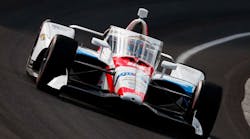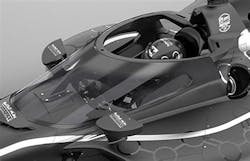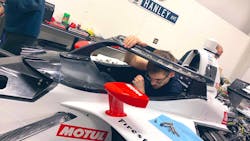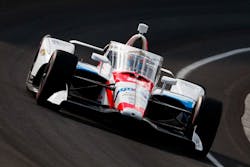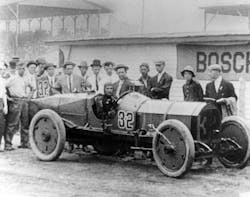Indy Cars Get a Little Safer—Thanks to a 200+ mph Windshield
Driver safety is always a top priority in professional car racing, maybe even more so at the IndyCar level. That’s why this year’s cars at Indianapolis will all be sporting an Aeroscreen, a wraparound windshield. It also has a stiffened frame that acts as a roll bar and strengthens the Aeroscreen’s structure.
IndyCar assembled a global team of experts to design and manufacture the screen. It included Red Bull Advanced Technologies (UK) for structural design; Dallara (Italy) for aerodynamic design; and manufacturers Pankl Racing Systems (Austria) for the top frame, Aerodine Composites (U.S.) for the lower frame, and PPG (U.S.) and Isoclima (Italy) for the screen itself.
The Aeroscreen is much like the Halo structure that surrounds and protects the top of the drivers’ heads (like a halo, get it?) used in Formula One. But Aeroscreen is also supposed to protect drivers from debris and wreckage coming right at them through the windshield. So, it includes a canopy-like wraparound window made from an aerospace material to reduce the dangers of getting struck by litter on the track and crashes.
The screen has a titanium top frame made of five 3D-printed members that are welded together than machined. For quality assurance. the welds are X-ray inspected, and after the five members are assembled, a 3D coordinate measuring machine (CMM) ensures it is properly aligned. The upper frame keeps large objects from getting into the cockpit and protects the driver’s head in case of rollovers. There’s also a titanium-reinforced carbon fiber lower frame built to stiffen the cockpit opening and give mechanics three mounting points for the top frame and screen. Carbon reinforcing on the rim of the lower frame increases stiffness of the composite structure the driver sits in, the tub, by more the 10%.
The titanium framework is connected at three points: the chassis centerline, two-rear side mounts and roll hoop integration. The configuration provides improved load-bearing capabilities up to 150 kilonewtons (kN). The window in the Aeroscreen is clear laminated polycarbonate.
To give drivers a clear view of the speedway in front of them from the start of the race to the finish, designers added eight sheets of clear plastic that can be pulled away one at a time from the surface of the polycarbonate window. The topmost sheet is exposed and can get dirty from—or even covered by—automotive fluid during the race. When the car pulls into the pits, a crewmember removes the top layer, giving the driver a new clear view.
An anti-reflective coating on the inside of the polycarbonate lets the rider see both the instruments and the road with less glare. The Aeroscreen also has a heating element in the middle of the polycarbonate laminate to prevent fogging.
In terms of crash protection, the Aeroscreen withstands 28,100 lb of vertical and lateral static loads. It could also handle hitting a 2.2-lb rock at 220 mph.
The Aeroscreen designers knew it would bump up the heat level inside the cockpit. To give drivers some relief, they added some ventilation. For road courses and short ovals, for example, an additional air inlet beside the trailing edge of the windscreen (on the left side of the cockpit, opposite the refueling inlet) can pipe air into the driver’s helmet. There are also more inlets in the nose of the ca—a high-pressure area—that can be opened and ducted to cool the driver’s legs.
Indy teams did have to deal with the extra weight and placement of the Aeroscreen. They had to rebalance the cars to maintain a good center of gravity. And they will have to factor the Aeroscreen in when they adjust the setups on the race cars suspension and aerodynamics.
Designers insisted that the new windshield have little or no optical distortion that could alter their view. It also doesn’t interfere with the driver’s sight lines so it doesn’t create any blind spots.
“The new Aeroscreen doesn’t obstruct my view of the road at all,” says Ben Hanley, driver for the DragonSpeed Team (which, by the way, is sponsored by Microwaves & RF and sister publications Electronic Design and Machine Design).
Another plus for the screen is that in case of accidents, drivers can be lifted straight up out of the cockpit through the top opening. This prevents the driver’s back, which could be broken at this point, from being injured any further.
A recent crash at this year’s Indy race in Iowa put the Aeroscreen to an unwelcome but satisfying test, according to IndyCar president Jay Frye. He noted that it did its job and prevented the nose, front wing and front tire of one car from penetrating the cockpit of another.
The Aeroscreen won the 54th annual Louis Schwitzer Award, which was presented to eight engineers for developing it: Ed Collings (Red Bull Advanced Technologies), Antonio Montanari (Dallara), Stefan Seidel (Pankl Racing Systems), Craig McCarthy (Aerodine Composites), Brent Wright, (PPG), Marco Bertolini (Isoclima),and Bill Pappas and Tino Belli from Indycar.
The design team won a $10,000 prize, which it graciously donated to the SeriousFun Children’s Network.
And just so you know: The award memorializes Louis Schwitzer, the driver who won the first auto race at Indianpolis Speedway in 1909. He also engineered the “Marmon Yellow Jacket” engine which helped take the the Marmon “Wasp” to the winner’s circle in the first Indy 500, held in 1911.
Be sure to watch the Indianapolis 500 this Sunday, Aug 23. The pre-race show starts on NBC at 1 pm (ET) with the race set to start at 2:30 pm. If you don’t have a favorite, join us in cheering for DragonSpeed.
